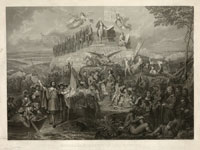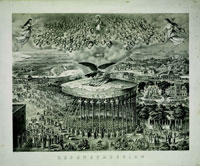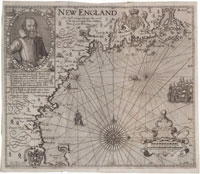Online Extras
Separated by a Common History Slideshow


Colonial Williamsburg
A seventeenth-century map of the Virginia colony, derived from Captain John Smith's observations.

Library of Congress
Columbus, Pilgrims, and presidents in a nineteenth-century engraving. A shared national history contained fissures that ended in Civil War.

Library of Congress
A northern vision of national reconciliation during Reconstruction reintegrated the South into the union.
Separated by a Common History
by Benjamin L. Carp
It may be true that England and America are “two countries separated by a common language,” as George Bernard Shaw said. By the same token, within the United States it sometimes seems as if the North and the South are separated by a common history.
The distinctions between North and South may be less relevant today than at any time since 1776. Yet the division of North from South is bound up in our understanding of American history.
In the seventeenth century, the peoples of the New World were a mix of Native Americans and white European colonists, along with black settlers and slaves. English colonists had little “common history” beyond their shared origins, a formal obedience to a distant monarch, and a reliance on the mother country for trade.
The American environment made the colonial experience new and different, but few people would have thought of the fledgling English empire as two distinct regions, New England and the Chesapeake. England’s holdings included the Caribbean sugar plantations, which far outstripped mainland America in economic importance, the settlements of Northern Ireland, and Bermuda. By the eighteenth century, the British Empire had added America’s Middle Colonies, the Lower South, and other dependencies across the globe.
Were colonists thinking in terms of North and South? Colonial American leaders primarily looked in four directions: eastward for goods, westward for land, upward for God, and down their noses at everyone else. English-speaking colonists regarded the Indians, Spanish, and French with fear, but distinctions of North and South within the British colonies were much less important. Some observers noted that slavery was making the West Indies and the mainland South distinct from the northern mainland colonies, but after all, every British colony allowed slavery. Southerners had no need to worry about threats to their particular way of life.
As communication across the Atlantic improved, as the colonies developed more trading connections with Great Britain and to each other, and as the colonists rediscovered British culture, English-speaking Americans drew on something more of a shared history. No two colonies were alike in institutions, needs, or development, but they had enough in common to make common cause, first against their enemies in the French and Indian War, and then, at least for thirteen of the colonies, against Britain during the American Revolution. Indeed, the alliance between New Englanders and Southerners drove the Revolution; the middle colonies lagged reluctantly behind.
Only when the Continental Congress began hammering out the parameters of a new nation did the South and North—particularly New England— begin to see each other at the opposite ends of a compass needle. Initially, they cooperated against Great Britain and developed a government. Eventually, they began to compete for resources, disagree over policies, and define different values for themselves.
In a 1785 letter to a friend in France, Thomas Jefferson referred to Northerners as “cool, sober, laborious, persevering . . . interested, chicaning, superstitious and hypocritical in their religion.” Southerners were “fiery, voluptuary, indolent, unsteady . . . generous, candid, without any attachment or pretensions to any religion but that of the heart.” Northerners were “jealous of their own liberties, and just to those of others.” Southerners were “zealous for their own liberties, but trampling on those of others.” To the thinkers of the late eighteenth century, climate explained these stereotypes.
James Madison wrote during the Constitutional Convention of 1787 that the great division of interests in the nation would not be “between the large and small states,” but “between the Northern and Southern,” which arose “from the effects of their having or not having slaves.” These differences and rivalries spurred clashes during the next hundred years: presidential contests, battles over trade, and the War of 1812. In 1813, former president John Adams asked Jefferson, “How shall we conjure down this damnable rivalry between Virginia and Massachusetts?”
Others reveled in the contrast. The New England statesman Daniel Webster, speaking in 1820 on the bicentennial of the Plymouth landing, said: “In other instances emigration has proceeded from a less exalted purpose . . . or more without plan and by accident, or under circumstances, physical and moral, less favorable to the expectation of laying a foundation for great public prosperity and future empire.” This was the year the Missouri compromise cleaved the western territory into permission and prohibition of slavery. The elderly Jefferson had written, “A geographical line, coinciding with a marked principle, moral and political, once conceived and held up to the angry passions of men, will never be obliterated; and every new irritation will mark it deeper and deeper.”
The ensuing decades provided new irritations to inflame sectional conflict: the nullification crisis in South Carolina, divisions over the Mexican War, Bleeding Kansas, and the Fugitive Slave Act. These were not just differences of opinion—Northerners and Southerners began to argue that the North and South represented separate strains of history. The caning of Massachusetts Senator Charles Sumner in 1856 by Preston Brooks in the halls of Congress was, in part, over proper recognition of South Carolina’s contributions to the American Revolution.
Sectional tensions erupted in four years of massive bloodshed. The Civil War, whose sesquicentennial beginning we commemorated, was a crushing Southern defeat, and its aftermath set the tone for generations of Americans. White Southerners were slow to forget their loss and the military occupation of Reconstruction: they embraced the role of victims in a Lost Cause.
During the decades that followed, northern writers rubbed salt in southern wounds by aggrandizing the northern view of American history. Henry Adams, grandson and great-grandson of presidents, was a believer in New England educational institutions. He wrote, “Strictly, the Southerner had no mind; he had temperament.” He didn’t intend it as an insult—he meant that the Southerners were feelers rather than thinkers, and that they might balance northern hardheadedness.
Still, in the minds of many offended Southerners, the institutions that had propelled the Adams family to greatness appeared to relegate the South to a secondary position in American intellectual life—including the study of history. Adams’s brother, Charles Francis Adams Jr., a president of the American Historical Association, wrote, “The Southern people have a dead-weight of Africanism tied to them, which is tending perpetually to hold back or pull down.” By contrast, “The passage of the Red Sea was not a more momentous event than the voyage of the Mayflower.” No surprise, then, that the Georgian historian Ulrich B. Phillips said in 1903, “The history of the United States has been written by Boston and largely written wrong.”
From the vantage point of a New England church steeple, historians were chronicling American history as a tale of holy mission, racial and economic progress, literary greatness, national unity, and military triumph. This vision consigns the South to a catalog of failures and atrocities: the disappearance of the Roanoke colony and the starvation and massacres of early Jamestown; the national stain of slavery and the Cherokee Trail of Tears; the dependence of a cash-crop economy and the pathologies of prickly southern honor; and the separatism of John C. Calhoun and Robert E. Lee. In this light, the story of the early South becomes a story of opportunism, oppression, racial and economic backwardness, treason, and military defeat. The Civil War had cast North and South in permanent roles as opposites.
As a result, wrote Peter Novick of the University of Chicago, “Pre-professional historical writing was overwhelmingly local and sectional, often in the most narrow and bigoted fashion.” Even historians such as Phillips described blacks as child-like and defended the plantation as a means of civilizing them. Other historians rationalized the Jim Crow laws of their days by calling the Civil War unncecssary and Reconstruction an atrocity. Yet the truth was also complex. Toward the end of the nineteenth century, white historians and politicians were hard at work reconciling northern and southern points of view—generally at the expense of African Americans. Northern historians criticized the abolitionist “irresponsible agitators” who started the Civil War. A Columbia University professor argued that though slavery was wrong, “Reconstruction was a punishment so far in excess of the crime” it erased southern guilt. Historians, in Novick’s view, bent over backward to appease southern views, well into the twentieth century.
Between the 1930s and the 1960s, historians from the North and South began to revise these interpretations. Most of these battles raged among historians of the nineteenth century, who often ignored colonial history, but these changing perspectives affected the study of the colonial period as well. Peter H. Wood of Duke University recalls his time as a graduate student in the late 1960s, studying “the early southern past, a domain of Indians, Africans, and Europeans that existed long before there was a New South, or even an Old South.” He wrote, “For all but a few historians, this varied and changing place had long been covered up or blotted out, mythologized, marginalized, or forgotten.”
In a 1979 survey of colonial history for an audience of southern historians, Allan Kulikoff, now at the University of Georgia, spoke of generations of “neglect caused by scholarly preoccupation with the New England colonies,” but said “the Chesapeake region has recaptured the attention of early American historians.” By the 1990s, a generation of new history books essentially had brought our knowledge of the southern and middle colonies into parity with New England.
Nevertheless, in 1996, Karin Ordahl Kupperman of New York University wrote that historians of Virginia ignored the seventeenth century, preferring to chronicle the deeds of George Washington and Thomas Jefferson to the Jamestown settlement’s ugly, opportunistic battle for survival. James Horn, O’Neill Director of the John D. Rockefeller, Jr. Library at The Colonial Williamsburg Foundation, wrote that “New England society has been interpreted as normative, the South as deviant.”
Jack P. Greene of Johns Hopkins University and other scholars turned this assumption on its head. In Pursuits of Happiness, Greene said that on the eve of the American Revolution, it was New England that differed sharply from the other colonies, and that the South closely resembled the other British colonies in its development. The South was wealthier and more open to the latest ideas from Europe; New England was more insular, more conservative, and more deeply mired in economic struggle. The South was central to an American culture that prized pursuit of individual happiness.
During the past fifty years, such scholars of the South as Wood, Kulikoff, Kupperman, Horn, and Greene have transformed the profession, and have the accolades to show for it. Southern historians not only have their own conferences and journals, but they often set the agenda for our discussion of the whole of American history. The complaint of a “neglected South” seems increasingly stale, a relic.
Just as mass culture, markets, and communication have softened regional differences, American historians have brought North and South closer. Rather than looking at individual case studies, scholars are starting to see commonalities in the way that ethnic conflict and racial relations developed in the North and South. Expansionism, imperial arrogance, localist suspicions, and agrarian developments were common to both regions. We have come to appreciate not just the importance of the Jamestown colony and the contributions of the South to the American Revolution but southern contributions to early American literature and ideas, religious enthusiasm, religious freedom, and visions for national economic development.
Historians have moved away from treating colonial America as a patchwork of regions and linked America’s eastern seaboard to the Atlantic world of Europe, Africa, the Caribbean, and South America, and the broader scope of the North American continent as well as the Pacific, the Indian Ocean, and the Middle East. Historians are studying the dynamic interactions of the American borderlands, the pathways of continental and oceanic trade, and the networks of religion, intellectual exchange, and imperial administration.
Still, as long as groups of Americans assert a particular regional identity, organize politics along regional lines, and discern patterns of regional difference, we will continue to slice American history along sectional lines. The North may not always come out on top, as it once did. The South may not always enjoy the most distinctiveness. We will likely find that colonial American history is neither separate nor held in common, but something in between, and more richly complex.
Rather than see New Englanders as holy missionaries or holier-than-thou Puritans, or see Southerners as honorable cavaliers or struggling drudges, we can see what all American colonists had in common. They struggled against challenges in an environment new to them, but they brought notions of hierarchy that led to terrible oppression. They pursued individual interests but knitted themselves together in communities. They sought prophets and took profits. And this was true of Indians and blacks as well as whites. They were human, which made them both more and less than our stereotypes would suggest.
Benjamin L. Carp, an associate professor at Tufts University in Medford, Massachusetts, teaches colonial, revolutionary, and early American history. He is the author of Defiance of the Patriots: The Boston Tea Party and the Making of America (Yale University Press, 2010). He contributed “Terms of Estrangement: Who Were the Sons of Liberty?” to the winter 2012 journal.
Suggestions for further reading:
- Edward L. Ayers et al., All Over the Map: Rethinking American Regions (Baltimore, 1996).
- L. Diane Barnes, Brian Schoen, and Frank Towers, The Old South’s Modern Worlds: Slavery, Region, and Nation in the Age of Progress (New York, 2011).
- Joseph A. Conforti, Imagining New England: Explorations of Regional Identity from the Pilgrims to the Mid-Twentieth Century (Chapel Hill, NC, 2001).
- Jack P. Greene, Pursuits of Happiness: The Social Development of Early Modern British Colonies and the Formation of American Culture (Chapel Hill, NC, 1988).
- Peter Novick, That Noble Dream: The “Objectivity Question” and the American Historical Profession (Cambridge, 1988).

